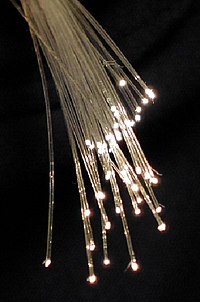
Photo from wikipedia
We proposed a novel torsion sensor based on inter-core mode coupling in seven-core fiber (SCF). The torsion sensor is fabricated by tapering a commercially available SCF spliced with two single… Click to show full abstract
We proposed a novel torsion sensor based on inter-core mode coupling in seven-core fiber (SCF). The torsion sensor is fabricated by tapering a commercially available SCF spliced with two single mode fibers. Waist diameter and length of the taper structure were experimentally optimized to achieve good transmission spectrum. Based on this structure, the torsion measurement was conducted, and the experimental results demonstrated that the transmission spectrum shows a red shift with the fiber twist. The torsion sensitivity increases with the twisting angle, which can achieve as high as 1.00 nm/°. The direction of wavelength shift was observed to be opposite when twisting the tapered SCF in clockwise and counter-clockwise direction, demonstrating its capability to discriminate the rotation orientation. Moreover, all the measurements were repeated in attempts to confirm its stable performance as well as high accuracy. Mode coupling dynamics and theory of optical anisotropy in twisted fiber are adopted to discuss the sensitivity performance, which agrees well with experimental results. The novel torsion sensor could provide a promising candidate for the applications requiring accurate rotation.
Journal Title: Optics express
Year Published: 2018
Link to full text (if available)
Share on Social Media: Sign Up to like & get
recommendations!